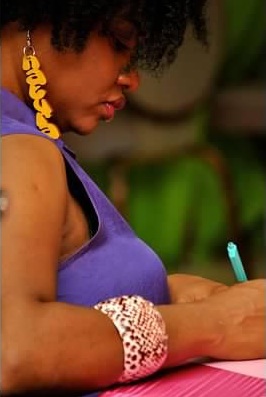 Reversing your hair to its natural state is a journey which involves a phase
commonly referred to as transitioning. Usually this phase would span the period
between your last relaxer and your big chop (cutting all your relaxed hair
off). The duration of the transitioning period varies from person to person
depending on the desired length the individual wishes to achieve after the big
chop. For many persons, the process is very brief as they are comfortable
wearing a mini afro, which is sometimes as short as a half of an inch. For
others, the period can be very extended as they wish to achieve fairly long
hair after they do their big chop.
Reversing your hair to its natural state is a journey which involves a phase
commonly referred to as transitioning. Usually this phase would span the period
between your last relaxer and your big chop (cutting all your relaxed hair
off). The duration of the transitioning period varies from person to person
depending on the desired length the individual wishes to achieve after the big
chop. For many persons, the process is very brief as they are comfortable
wearing a mini afro, which is sometimes as short as a half of an inch. For
others, the period can be very extended as they wish to achieve fairly long
hair after they do their big chop.
Regardless of your preference, there are some basic tips, that if applied, can
make the transition phase less frustrating. These tips are as follows:
1. Handle Your Hair With Care
It is extremely important to exercise care when handling transitioning hair.
During the transitioning process you will be faced with hair of two different
textures: the natural unprocessed hair and the relaxed hair. The point at which
both hair types meet is especially fragile, and as such you should avoid
excessive manipulation as it can result in breakage.
One common process in the hair care regimen that requires manipulation is
that of detangling. For this reason, extra care needs to be taken when
executing this process to avoid breaking off or tearing out your hair. To
prevent this from happening, be sure to be very gentle, use a wide tooth comb
and use lots of moisturizing conditioner.
The rule of the game is always to try a little tenderness.
2. Avoid The Heat Horror

One option frequently explored by transitioners is that of flat ironing. This is usually in an effort to straighten the new growth for it to match the relaxed texture. This, unfortunately, is not the healthiest option for your hair. For one, flat ironing will, overtime, cause a noticeable change in your natural curl pattern. This can result in the natural portion of your hair losing elasticity, which is the hair's ability to stretch and return to its original state. The loss of elasticity is usually the first sign that heat damage has occurred. Usually this is observed after washing your hair. If the hair becomes limp or looks straight when wet, then chances are heat damage has occurred.
Unfortunately, the only way to get rid of heat damaged hair is to cut it off. 
This will further delay the transition process as you would now have to wait for new growth to occur if you wish to start off your natural hair journey with a healthy head of hair.
In light of this potential threat of heat damage, it is advisable to avoid
frequent use of hot irons during the transition period. Instead of
straightening the new growth to match the processed hair, you may want to
consider doing styles that causes the relaxed texture to mimic that of the
natural texture. There are many options to achieving this effect. Installing
small, tight curls by doing wet sets using flexi rods, perm rods etc, is an
effective method. Likewise, doing two strand twists, braids, plaits or bantu
knots and then taking them loose also work like a charm. Consider these
options, as they could help to successfully blend your two hair textures.

3. Wear Protective Styles
Often times during the transitioning phase, it seems as though your hair is simply not growing fast enough. It is during these times that temptation will creep in and you may contemplate returning to your "trusted" relaxer. If you however, are committed to completing the natural hair journey, some patience is required. Be not dismayed, your hair is in fact growing, usually at a rate of a half an inch each month. The new growth however, because of its tendency to shrink up, may not appear to be growing at a fast enough rate.
One way to avoid obsessing about your hair length is to wear protective styles.
This would mean that your hair will remain tucked away and as such you will not
be able to track your hair growth progress on a daily basis. There is a popular
Jamaican saying that goes "wa eye nuh see, heart nuh leap" which in
essence translates to mean if you can see it, you won't stress about it.
Another advantage of wearing protective styles is that it keeps handling and
manipulation of your hair to a minimum, which results in your hair being able
to maintain better health. They also rid you of some of the stress of having to
figure out new and creative ways to wear your hair so that it looks well kept
at all times.
There are many protective styling options including braids, weaves, wigs or
just wearing your own hair in flat twists, cornrows, bantu knots etc., if fake
hair is not your thing. Each of these styles is low maintenance and can prove
to be a life saver during this somewhat challenging phase.
4. Record Your Hair Goal
Making a list of reasons you decided to transition to natural and writing down your natural hair goal can help to keep you on track. If ever you get discouraged or find it difficult to keep up with the demands of transitioning, just pull out your list and refresh your mind of these goals and aspirations. This should keep you motivated to achieve them.

5. Team Transition!!!
Teaming up with an individual or individuals who are going through the same phase as you are may prove very helpful. Sometimes the natural hair journey can become very lonely and having a friend or associate to share in the experience and encourage you along the way is likely to make it more exciting and keep you motivated.
6. Deep Conditioning
Doing weekly deep conditioning with moisturizing conditioners will help to strengthen and soften your new growth and relaxed hair. Having soft, manageable new growth will help to prevent breakage.
Many transitioners complain about coarse, unmanageable roots. This is one of
the many reasons why some people abandon their natural hair journey. Committing
to having your hair deep conditioned regularly will make your hair look and
feel softer.
7. Trim Regularly
Trimming your hair at least once a month or in between protective styles will help to gradually get you closer to your hair goal. Many transitioners are unwilling to do a drastic, one time big chop and so it is easier to approach it in stages. Regular trimming will also get rid of damaged ends caused by heat or relaxers.
8. Wearing Headbands

Wearing headbands is a great way to tame that sometimes unruly new growth and keep it nice and sleek.
A headband can work with almost any hairstyle done with your own hair. It is a
fun way to jazz up your hair and add some element of variety to your look.
The broader headbands work better for this purpose. You can experiment with a variety of colors, styles and textures.
Transitioning, though at times challenging, is well worth it. In the end, when your goal is realized, you will most definitely say it was worth it all. Hang in there, the best is yet to come.

Candie's Natural Hairnamix was birthed a few months after Jamaican native Rossette "Candie" Allen began her natural hair journey in May 2010. She gears this column toward naturals, transitioning naturals, aspiring naturals and the naturally curious, sharing experiences, expertise and experiments while celebrating emancipation from chemical slavery.

